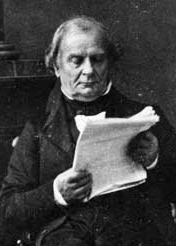Émile Clapeyron facts for kids
Quick facts for kids
Émile Clapeyron
|
|
|---|---|
 |
|
| Born | 26 January 1799 |
| Died | 28 January 1864 (aged 65) |
| Nationality | French |
| Known for | Second law of thermodynamics Ideal gas law Clapeyron's theorem Clapeyron's theorem of three moments Clapeyron equation Clausius-Clapeyron relation |
| Scientific career | |
| Fields | Physics |
Benoît Paul Émile Clapeyron (born January 26, 1799 – died January 28, 1864) was a French engineer and physicist. He was one of the important people who helped create the science of thermodynamics. Thermodynamics is the study of how heat, work, and energy are related.
Contents
Early Life and Education
Émile Clapeyron was born in Paris, France. He was a very bright student. He studied at the famous École polytechnique, a top engineering school. He finished his studies there in 1818. He also went to the École des mines, which is a school for mining engineers.
Career and Railways
In 1820, Clapeyron moved to Saint Petersburg, Russia. He went with his friend Gabriel Lamé. They taught and worked at a public works school there.
After the Revolution of July 1830 in France, Clapeyron returned to Paris. He became very involved in building the first railway lines in France. These lines connected Paris to Versailles and Saint-Germain. This was a big step for transportation in France.
He even took his ideas for steam engines to England in 1836. He wanted to find a company to build them. He worked with a company called Sharp, Roberts and Co.
From 1844 to 1859, Clapeyron was a professor. He taught at the École des Ponts et Chaussées, another important engineering school.
Contributions to Science
Clapeyron made major contributions to thermodynamics. This is the study of how heat and energy work.
Understanding Heat Engines
In 1834, Clapeyron published an important report. It was called Mémoire sur la puissance motrice de la chaleur. This means "Memoir on the Motive Power of Heat." In this report, he built upon the ideas of another physicist, Nicolas Léonard Sadi Carnot. Carnot had studied how heat engines work.
Carnot's work was brilliant, but it was hard to understand. Clapeyron made it much clearer. He used indicator diagrams to show the Carnot cycle. This is a special way to show how a heat engine uses pressure and volume. These diagrams are sometimes called Clapeyron's graph in his honor.
Reversible Processes and Thermodynamics
Clapeyron also helped develop the idea of a reversible process. This is a process that can be reversed without any loss of energy. He made a clear statement of Carnot's principle. Today, we know this as the second law of thermodynamics. This law explains how heat flows and why some processes are impossible.
Clausius–Clapeyron Relation
His work helped Rudolf Clausius develop more ideas. One important result is the Clausius–Clapeyron relation. This formula helps us understand phase transitions. A phase transition is when matter changes from one state to another. For example, when ice melts into water, or water boils into steam.
Other Important Work
Clapeyron also studied perfect gases. He looked at how they behave under different conditions. He also worked on how solids stay in balance.
In engineering, he developed the theorem of three moments. This is also known as Clapeyron's theorem. It helps engineers calculate the forces in continuous beams used in buildings and bridges.
Honors and Legacy
Émile Clapeyron received many honors for his work.
- He became a member of the Académie des Sciences in 1858. This is a very respected scientific group in France.
- A street in Paris is named after him: the Rue Clapeyron. It is in the 8th area of Paris.
- His name is also one of the 72 names inscribed on the Eiffel Tower. This honors important French scientists and engineers.
See also
 In Spanish: Émile Clapeyron para niños
In Spanish: Émile Clapeyron para niños

